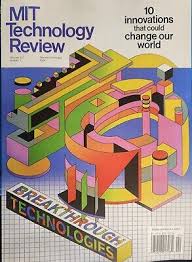Each year, the MIT Technology Review takes a look at “promising technologies posed to have a real impact on the world.” And each year I enjoy taking a look through their picks.
Not surprisingly, the first technology cited was AI. After all, something AI-related has had a spot on pretty much every future/breakthrough tech list for the last couple of years. In this case, the technology that gets the nod is Generative AI which, thanks to tools like ChatGPT has “reached mass adoption in record time.” There were initial hiccups, like Microsoft’s Bing Chat generating gibberish and Google’s Bard giving out wrong information. But the technology providers rebounded quickly. Users are on their way to taking care of routine office tasks (e.g., summarizing emails) and creating images. “Never has such radical new technology gone from experimental prototype to consumer product so fast and at such scale.” What’s lagging behind is figuring out exactly what its impact will be.
providers rebounded quickly. Users are on their way to taking care of routine office tasks (e.g., summarizing emails) and creating images. “Never has such radical new technology gone from experimental prototype to consumer product so fast and at such scale.” What’s lagging behind is figuring out exactly what its impact will be.
We have a better idea what the impact of the first gene-editing treatment is going to be. That first treatment, from Vertex, tackles sickle-cell anemia. The good news: it works and is curing patients. The bad news: it’s prohibitively expensive – way too expensive and complex to deploy in Africa, which is where it is most needed, given that virtually all those who suffer from sickle-cell are Black. Next up: simpler, cheaper delivery mechanisms.
Heat pumps seem like a rather old-school technology to be on a list of breakthroughs, but now they’re coming into their own. Heat pumps that run on renewably-sourced electricity can decrease reliance on fossil fuel power, substantially cutting emissions. To date, heat pumps have been used largely in homes and offices, but they’ll soon be used in manufacturing, where the impact can be especially significant.
Tech Review sees Twitter killers as breakthrough, as users concerned with the problems that have beset Twitter (or X, if you like) since the takeover by Elon Musk have been drifting off that platform and onto decentralized, better-modified, and more secure sites like Meta’s Threads, which now has nearly 100 million monthly users. Even though Twitter’s traffic and number of daily users are down, Twitter’s 120 million daily users dwarf Threads’ monthly numbers.
Back on the energy front, there are enhanced geothermal systems, which use hydraulic fracturing (a.k.a., fracking) to enable energy extraction under an expanded number of geological conditions, increasing energy production. The jury’s still out on whether hydraulic fracturing will do more harm (increase in seismic activity) than good (more renewable energy), but for now Tech Review’s got eyes on.
You may have been seeing ads for appetite-suppressing weight-loss drugs (Oh, Oh, Oh, Ozempic) that are now cleared for use by those looking to lose weight, rather than just for the previous use case of diabetes control. Weight-loss drugs are expensive – upwards of $1,000 a month – and the costs are not generally covered by insurance for weight loss. There are a number of unpleasant side effects, and many have found that, once they go off the drugs after achieving their desired weight loss, they quickly gain those lost pounds back. But a lot of pharma companies are coming up with new drugs, and it may not be all that long before there’s a cure for obesity.
What else does Tech Review see as major breakthroughs?
Chiplets, the “smaller, more specialized chips [that] can extend the life of Moore’s Law.” Rather than focusing on trying to make transistors smaller and smaller, and “cramming” chips full of them, chip manufacturers have turned their sights to chiplets, purpose-built for a specific function. Emerging standards will make it possible to more easily combine chiplets from different manufacturers.
New technology is enabling the creation of super-efficient solar cells. That new technology is perovskite solar. “When silicon and perovskites work together in tandem solar cells, they can utilize more of the solar spectrum producing more electricity per cell.”
Other face computers (Google Glass, Microsoft HoloLens…) have failed to gain much traction, but Apple’s Vision Pro, with a much better display, may be the breakthrough device the market has been waiting for. Apple calls it a spatial computer, the Vision Pro is “the company’s first mixed-reality headset.” It differs from virtual reality in that it “overlays digital content onto your real-world surroundings. Vision Pro utilizes two micro-OLED displays, which produces a higher res experience than what you get from other VR headsets, which use liquid crystal displays. At $3,499, the Vision Pro is ultra-expensive, but it’s Apple so folks may be willing to pay up.
Finally, exascale computers “capable of crunching a quintillion operations per second are expanding the limits of what scientists can simulate.” Quintillion, huh? Remember when we used to think a billion was a big number? Anyway, the big question hovering over these super-duper computers is energy consumption.
That’s it for the Tech Review’s 2024 technology breakthroughs. A pretty good list. Do you think they missed anything?
